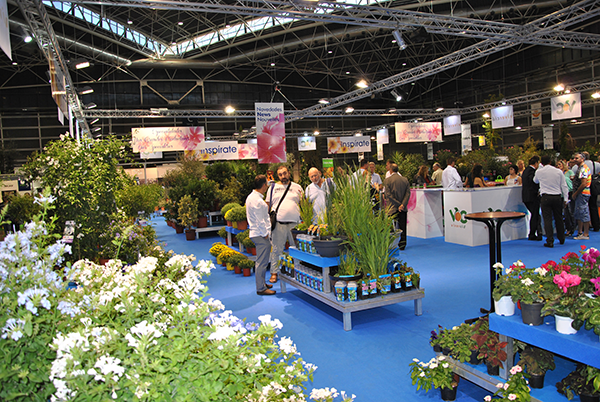Kai Hattendorf is CEO of the Global Association of the Exhibition Industry (UFI). In this exclusive interview, published in December 2021’s edition of FloraCulture International, he talks about how the sector will need to continue to factor in uncertainties.

FCI: Almost twenty months have passed since the World Health Organisation declared Covid-19 a pandemic, causing massive disruption to the global exhibition industry. Where are we now?
Kai Hattendorf: “These are “in-between” times. After a catastrophic 2020, our industry saw more reason to be hopeful in 2021. This year, markets began to re-open around the world – but not with the full reopening we had hoped for, as we continue to be challenged by new waves and new variants of COVID. We are still facing an outlook of ‘stop and go’ for show organisers – the most difficult situation possible for our industry. But as we head towards the end of the year, we have passed a remarkable tipping point: Less than a year after the first vaccination campaigns began, more than half the world’s population have received at least one dose, with more than 26 million doses of the vaccine being given daily.
“We are regularly taking the “pulse” of the global industry in our “Global Exhibitions Barometer”, and I invite your readers to download this report from our research website https://www.ufi.org/research for the complete picture. But in a nutshell – the industry is bouncing back from the catastrophic year 2020 everywhere around the world, and 2021 will only be the beginning of many years of strong growth.
“Generally, there is a strong belief that the sector, primarily driven by physical exhibitions and business events, will bounce back quickly. The proportion of companies globally that are reporting ‘normal activity’ has increased from 12 per cent to close to 50 per cent. These results vary depending on region, and are primarily driven by the currently confirmed or expected ‘reopening dates’ for exhibitions. The majority of companies in all regions expect both local and national exhibitions to open again in the coming 12 months, and international exhibitions to reopen in the first half of 2022.”
How long will the pandemic’s impact last?
“We have always been faced with disruption in our industry, that has always been a part of the ‘old normal’ – remember volcanic eruptions, financial and political crises, or previous health crises.
“It is impossible to say when we will have beaten the pandemic globally. I already spoke about the ‘stop and go’ we have to live with – this will define our work for quite a while still.
“And when we eventually arrive in the ‘new normal’, changing challenges and ongoing disruptions of some kind will be just as much an element of our normal life as they have been in the past.”
Trade show professionals tell us that in the pandemic era trade shows that are targeting audiences on a local scale, for example in China, are faring better than truly international trade shows; the ones we see, for instance, in Germany. Can you elaborate?
“At UFI, we are seeing the same. As markets reopen, the regional and national events are the first to restart, as they rely less on a wider international or global audience. China, the US, and the EU as a block are huge internal markets, so the industry is bouncing back fast. Shows that are focussed on a global audiene have a harder time, given ongoing travel restrictions and challenges.”
Trade show planning pre-Covid-19 versus trade show planning in the pandemic era; everyone is making decisions so late. What is the impact on the global exhibition industry?
“We have to live with these uncertainties. And we have to factor them in. Many organisers are in regular contact with their exhibitors now in the run up to a show, exchanging the news and updates around the event – to jointly see how a show can best serve an industry. What we see everywhere around the world: It is the right decision to run a show if you can do so safely – there are fewer exhibitors and visitors, but the business they make is crucial.”
Some industries have been doing well during the pandemic and will likely continue to do so under the new normal. Think online retailing giants, liquor stores, game companies, the second-hand car market, fitness equipment companies and even garden centres. One could argue they some industries actually don t need a trade show. What’s your view?
“Trade shows are the central market places and meeting places for every industry, every commercial community. They are essential. Business is based on relationships – in good times and in bad times. As soon as a boom in one sector ends, the businesses who have not invested in these relationships are the ones who suffer the most.”
Over the past 20 months, virtual and hybrid events have become increasingly popular. What do you think the global exhibition industry has learned so far in what works and what does not work?
“We have learned that there are elements where digital offers good solutions: On content for example. We have also seen – once again – that ‘digital exhibitions do not work. We recently released a survey where we asked exhibiting companies to rate digital trade shows – the result is a Net Promoter Score of -51. I have never seen such a poor score before.
“So the main learning is simple: There is huge potential in digital solutions and services to make the real event better, and to offer digital services in between the face to face platforms. Most likely the leading companies in our sector ten years from now will be those who have embraced these opportunities in the best way.”
The educational/congressional part of the trade show business seems to work very well online. And is interesting to see how those educational sessions attract a younger and less traditional trade show audience, often coming from a much wider community. Do you feel that trade show online content is well-aligned with its audience?
“That differs from industry to industry, and from show community to show community. What we see is that, through the pandemic, show brands have indeed found a new, wider digital audience. And our research shows that these – mainly young – professionals are now eager and keen to move from a digital only participation to attending the real event.”
Already pre-Covid-19, the global exhibition industry was under pressure with people expecting the most individualised breadth possible in a defined area as to avoid much lost time while attending. At the same time competition between trade shows is extremely fierce. Investing in online platforms requires deep pockets. Do you expect profit margins to decrease or will a trade show still be as profitable as it used to be?
“For every business to suceed, it needs to be profitable. New digital products and services will open up new revenue streams, while the traditional ones are bouncing back. There will be challenges for sure – we all need to make more efforts to make our events carbon neutral for instance – but at the core this will remain an industry where good show organisers will earn good money.”
COVID-19 has absorbed much of your attention lately. Nearly to an extent that we would have almost forgotten that the single biggest global challenge is not the pandemic but climate change. What are concrete actions needed in the exhibition industry?
“UFI has been driving an industry wide initative on this, the “Net Zero Carbon Events Initiative”. Backed by the United Nations, we now have a pledge for the whole events industry to produce Net Zero Carbon Events by 2050 at the latest. I encourage everyone to join this project and work with us on getting there. All the information is on www.netzerocarbonevents.org “
Under the current circumstance, what is the best advice you would give to someone who is thinking about setting up a new horticultural trade exhibition?
“I am certainly not an expert in that field – so my advice can only be generic: Make sure you can build the best possible market place for the businesses you want to attract, and do everything you can so that they can be successful. Their success will be your success as well.”
UFI At A Glance Facts
- UFI is the leading global association of the world’s tradeshow organisers and exhibition centre operators, as well as the major national and international exhibition associations, and selected partners of the exhibition industry.
- UFI’s main goal is to represent, promote and support the business interests of its members and the exhibition industry. UFI directly represents around 50,000 exhibition industry employees globally, and also works closely with its 62 national and regional associations members.
- 783 member organisations in 84 countries and regions around the world are presently signed up as members. Well known within the ornamental horticulture industry are UFI members Messe Essen (IPM Essen), Messe Frankfurt (Christmas World), Koeln Messe (spoga+gafa), Fiera Milano (My Plant&Garden), Shanghai Intex (Hortiflorexpo IPM Shanghai), PadovaHall (Flormart) and Crocus Expo (FlowersExpo Moscow).
- More than 910 UFI approved (International) events proudly bear the UFI approved label, a quality guarantee for visitors and exhibitors alike. UFI members continue to provide the international business community with a unique marketing media aimed at developing outstanding face-to-face business







